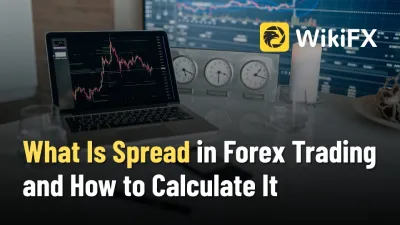What Is Spread in Forex Trading and How to Calculate It
Spread Meaning in Forex Guide: Forex spread defines the bid-ask price differential, representing the cost of entering a trade instantly.
简体中文
繁體中文
English
Pусский
日本語
ภาษาไทย
Tiếng Việt
Bahasa Indonesia
Español
हिन्दी
Filippiiniläinen
Français
Deutsch
Português
Türkçe
한국어
العربية
Abstract:While occurring in trading as empty spaces between the opening and closing of a trade, a gap cannot be avoided in financial trading.

Gaps in trading are a common phenomenon and very commonly occurring in stocks but also occur less frequently in forex trading.
Gaps are important because they can give an idea of market sentiment. Therefore, understanding the gap forex concept, significance, and gap trading strategy is essential for success in forex trading.
What Is Gap in Forex?
Gap is a break in price on the chart of a financial asset, namely, the situation where an unusually large space appears between two adjacent bars. See the picture above for more details.
From a technical analysis' perspective, a gap in the forex market occurs when the opening price is either higher than the previous session's high price (gapping up), or lower than the previous session's low price (gapping down).
From a fundamental analysis' perspective, gap in forex can be explained by a strong shift in trader sentiment regarding an asset price. When a market gaps up, that means there were zero traders willing to sell at the levels of the gap. When a market gaps down, that means there were zero traders willing to buy at the levels of the gap. Gaps can be classified into the following four types:
1. Breakaway gap
A break away gap is typically formed at the start of an uptrend or when price is just coming out of a consolidation phase. It is known as a breakaway gap because price tends to break out from its previous consolidation to establish a new market move.
If a breakaway gap is accompanied by higher trading volume, it may be worth taking a position long for a breakaway gap up, and short for a breakaway gap down, on the candle following the gap.
2. Continuation or runaway gap
This type of gap is formed within the prevailing trend and is usually said to occur mid way of a trend. When a runaway gap is identified, traders know that the previous trend will continue and trade in the direction of the trend. Trading the continuation or runaway gap is probably one of the safest methods to trade, especially when combined with other trading methods such as support/resistance or trend lines. The chart below shows a continuation gap that was formed in the middle of the uptrend.
3. Exhaustion gap
An exhaustion gap is usually seen in the final leg of a downtrend or an uptrend. This is often caused by a herd mentality of traders rushing to the trend and moving the stock into overbought territory. Therefore, experienced traders will be watching for the reversal and take the contrary position to the prior trend.
4. Common gap
This is one of the least important gaps and is formed, as the name suggests, commonly. Common gaps can be formed at any time of the trading session. Common gaps are more likely to be filled within a few price bars and can therefore be used for very short term intra-day trading. The chart below shows a common gap that was formed, notice how quickly this gap was filled.
Why Are Gaps so Important?
Gaps can give an idea of market sentiment. When a market gaps up, that means there were zero traders willing to sell at the levels of the gap. When a market gaps down, that means there were zero traders willing to buy at the levels of the gap. There are also important to be aware of because it is possible to gap past a stop order and get filled at worse price than your stop order.
Gaps sometimes result in corrective price action. In other words, after the gap occurs prices have a tendency to reverse and “fill” the gap.
Gap Trading Strategies in Forex
Traders noticed the following regularity: when a gap is being formed, the price often tends to fill this price break. A gap being 'filled' refers to the price returning to the original level before the gap happened. This usually means the price action, in the following days or weeks, retraces to the last day before a gap.
The given statistics applies particularly to weekly gaps, since intraday gaps occur much less frequently and are formed as a result of high-impact news releases. Filling such gaps can happen for several days or even weeks, because the news can be so important that investors will not soon be able to believe that the price can actually return to the previous levels.
Therefore, determining weekend price gaps in forex currency pairs and entering trades that aim for the gap to be filled before Tuesday's closing has been a very simple and profitable trading strategy.
Gap trading rules to consider:
Classify the gap you are going to play: It's important to know which of the four types of gap you have identified. A continuation gap will prolong a trend while an exhaustion gap is set to reverse it – two very different outcomes.
Assets: look for highly volatile forex pairs such as GBP/USD, EUR/USD, USD/JPY and USD/CHF.
Traders need to set the take profit for the previous weeks range, while the stop loss must never be larger compared to the amount of pips aimed by the take profit level.
Be careful: Trading the gap means trading stock market volatility with low liquidity so caution must be exercised.

Disclaimer:
The views in this article only represent the author's personal views, and do not constitute investment advice on this platform. This platform does not guarantee the accuracy, completeness and timeliness of the information in the article, and will not be liable for any loss caused by the use of or reliance on the information in the article.

Spread Meaning in Forex Guide: Forex spread defines the bid-ask price differential, representing the cost of entering a trade instantly.

Allied Top review: Covering regulation, trading platforms, leverage, spreads, deposits, and real trader feedback for informed decisions.

Global broker STARTRADER refreshes its brand identity, reinforcing trust, growth, and client focus through a modernized visual and strategic repositioning.

Dear Global Users, Thank you for journeying alongside WikiFX. Every query you make, every review you share, and every piece of feedback you provide serves as the most vital driving force behind our continuous efforts to promote transparency and security in the trading industry.
